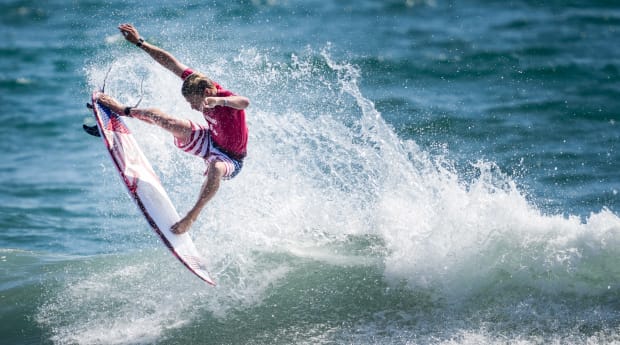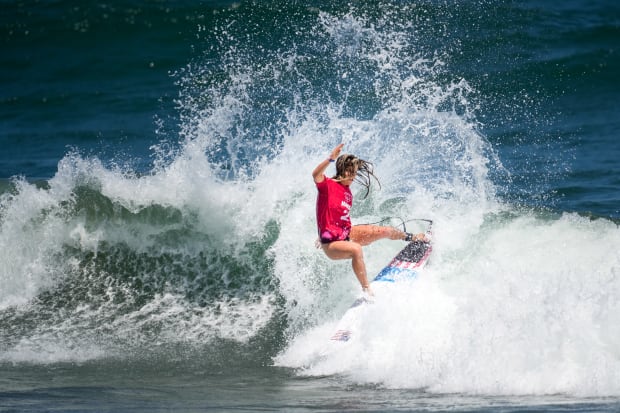Kolohe Andino, John John Florence, Carissa Moore and Caroline Marks all advanced to the quarterfinals on Monday in Tokyo, as they relished in the Olympic experience.
TSURIGASAKI SURFING BEACH, Chiba Prefecture — Imagine what it might have looked like, this pristine stretch of sand about 60 miles from Tokyo on Japan’s east coast. Imagine the party, the grandstands packed with revelers, everyone drinking and swaying and socially not distancing as surfing made a raucous Olympic debut.
This is what it did look like, in a rare instance when reality was different—no stands, no spectators and, alas, no alcohol—and yet altogether not much worse. There were still surfers, like the four Americans who competed here on Monday. There was a big screen set up near the ocean, close enough to catch the spray. There was wind, the vicious kind, the head-inside kind, that sent national flags into a back-and-forth tizzy. And because of that beach, and those surfers, and that wind, a sport that expected to confront smaller waves here suddenly had big ones that crested and broke and swallowed up competitors.
Kolohe Andino, a California surfer who goes by Brother, who loves overheated saunas, his hometown Dodgers and vegan tacos, stood on that beach and prayed. For a moment, he felt “overwhelmed with emotion.” A lifelong Olympics obsessive, a fan of Michael Phelps and Jessie Diggins and Usain Bolt, he asked for strength, and he asked for wisdom. “This is the biggest heat in American history,” he thought to himself, “and I get to be a part of it.” Then he paddled into the choppy water with fellow U.S. competitor John John Florence, and with those massive breaks crashing overhead, chose to ride the first wave.

What happened next wasn’t exactly Phelps by a fingertip, or Diggins winning gold by half a ski. But for surfing, for now, it worked. Clad in stars-and-stripes board shorts and a red No. 4 jersey, Andino sailed along a wave, turned sharply, flipped around and landed. In a text message, he said this particular maneuver was called a “slob grab air reverse.” Had there been a crowd, it would have roared. He made a slashing gesture across his throat—spontaneous, he says, since he and Florence are friends—and smiled wide.
At that point, Andino knew he had pulled off perhaps the best move of the Olympics. Of course, it’s only Day 2. He’d rather win a gold medal, joining his pantheon of Olympic heroes. But for now, he had done what he wanted, topping Florence to advance to Tuesday’s quarterfinal round, where three of the 16 competitors remaining hail from the United States.
For a surfer who once spent half a competition turned around in the ocean, flipping both middle fingers at the judges, Andino tries to keep it simple now. He needed to remember how he arrived here, through the aid of his father (Dino, a former pro), a sports psychologist (Eric Potterat), an NFL quarterback (Sam Darnold). Plus, the physical therapist (Drew Morcos) who guided Andino’s recovery from a high-ankle sprain that threatened his Olympic dream.
That meant taking in the scene, the national team, the firsts. Like remembering what Kobe Bryant once said at a meeting with U.S. surfers; that they needed balance to reach their full potential. Like noticing the stands set up not for lifeguards but for camera people, their lenses beaming the sport he learned before he could walk, all over the world. Like the American flag that ricocheted in the wind. Like his teammates, Caroline Marks and Carissa Moore, who both advanced to the women’s quarterfinals, where they rank among the favorites. (It helps that seven-time world champion Stephanie Gilmore of Australia lost on Monday.)
For all of them, the surreal experience also meant competing while Tropical Storm Nepartak barreled toward Japan. Experts in such matters believed the brunt of the storm would mostly miss Tokyo, but the country’s meteorological agency still expected six inches of rain in places and up to 80 mile-an-hour winds. Other events were shifted to different days, as organizers hoped for better weather. But not surfing. Not now.

While this country calls to mind skyscrapers and city dwelling, it remains an island with less square mileage than California, meaning either the Pacific Ocean or the Sea of Japan are never far away. There’s a deep and fairly strong tradition for surfing here, where locals began a form of body surfing—called itago—two centuries ago and where millions of office dwellers ride trains to the beach and trade business attire for wetsuits in the parking lot.
All understand that surfing remains a sport of variables, many outside even the best competitors’ control. Last month, Andino sat behind home plate in Dodger Stadium, explaining how competitors must pick waves and then ride them, whether they materialize into what they’re looking for or not. He compares that exercise to Clayton Kershaw, on the mound, preparing to throw but not able to find the baseball. He had to learn to focus only on what mattered: his own strategy and mindset. Those he could control. To that end, he made slight training alterations, decreasing his strength training to be more flexible for the smaller waves and paying more attention to what he ate. In June, Andino told Sports Illustrated, “The waves are going to be pretty small, barring a freakish typhoon or something.”
The competition was not, ultimately, threatened by a typhoon. But the sentiment sounded eerie when the tropical storm closed in. But it didn’t bother Andino. He didn’t worry about his chances. He worried only about his performance in his heat.
He landed in Tokyo and rode away from the city toward the coast, past the modern houses and sleepy beach towns, the parts of Japan rarely highlighted by visitors. The beaches near the Olympic competition remained closed, with red flags planted to warn tourists and locals away. Fans could only watch the one-on-one matchups, scored by judges, the same way as the rest of the world: on TV.
Still, Andino walked in the Opening Ceremony, an experience so meaningful he said that afterward he could not sleep. He thought of one uncle, a veteran, and Camp Pendleton, the Marine Corps Base Camp near his hometown of San Clemente, Calif. The Olympics represented “the pinnacle,” because of the magnitude, his background, what they meant.
On Sunday, that pinnacle began. Moore, a four-time world champion, won the first-ever Olympic surfing heat. Everyone else advanced, which portended well, since both Florence and Andino spent much of the past year sidelined by injuries. The two-time champ Florence, in fact, ranked third in the world before he tore ligaments in a knee in May. The friends, now recovered or at least recovered enough to compete here, were bummed to have to surf against each other. It was basically the only thing about the experience they did not describe as “rad.”
Andino prepared himself mentally for the opposite of what happened, reminding himself to support Florence if Florence won. They were both Americans, both “big surf frothers,” which translates loosely to enthusiasts. But both knew: this was surfing, the elite part, the life they’d chosen, whether riding “ankle slappers or big-barrel standoffs.”
Florence knew he would be competing much sooner than almost any athlete on earth who’s facing the typical long recovery for a ligament tear. Still, he felt ready, if not surprised by Andino’s opening maneuver. Florence didn’t see it; he only noticed the score (8.5). “Oh, my gosh,” he thought. “What did [Andino] do?”
Still, Florence called the experience “amazing.” They both did, meaning for themselves, for their country and for their sport. They hope that Olympic officials extend surfing into the future, into Paris, where the event will be held in Tahiti; then Los Angeles; then Brisbane.
This? This felt transformative, especially for the surfer who had transformed himself over the last six years. For all his success, like three top seven finishes in the World Surf League from 2016–19, Andino has yet to win a championship tour event. He hopes to do that here, in the Pacific Ocean, to create a new favorite Olympic memory, starring, of course, himself.
More Olympics Coverage:
No comments:
Post a Comment